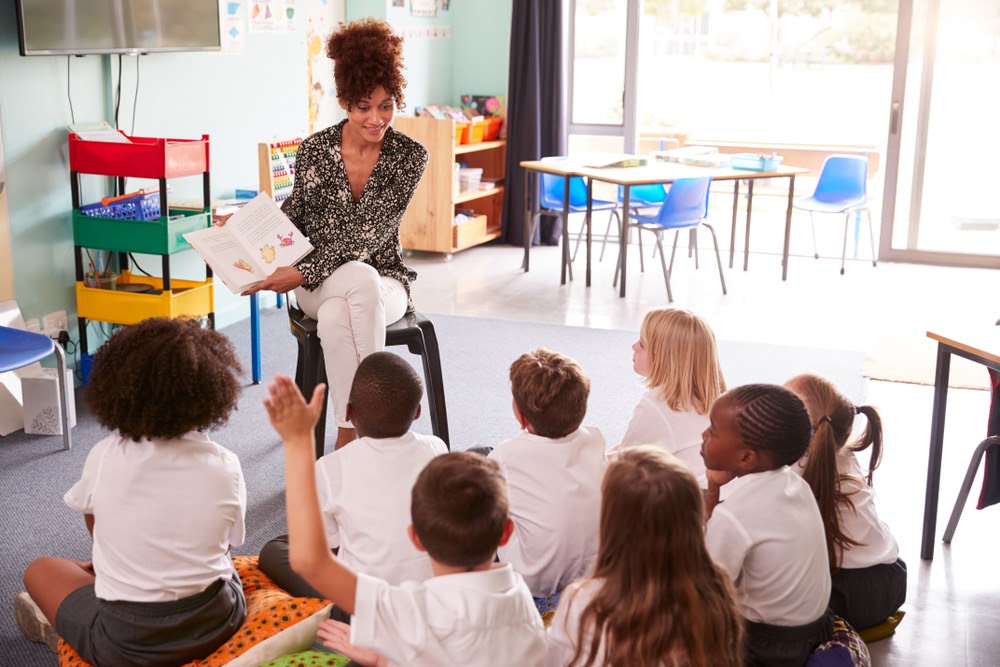
As virtual learning went mainstream during the pandemic, schools realized that they could pivot to remote learning for snow days, too. While the much-anticipated snow day often included sledding, snow men and sleeping in, many schools are now moving to virtual instruction instead of canceling classes.
When winter weather forces schools to close beyond the number of allotted snow days, the school year is often extended into the summer. Virtual instruction lets learning continue even when the days are snow-packed. Some subjects like reading may be challenging to teach virtually. How can you use Zoom to teach reading lessons?
For instructors who are looking for tips and suggestions for fun remote learning ideas to help students learn to read and gain proficiency, here’s how to Zoom into reading.

Zoom Reading Lessons for Younger Children
In classroom sessions, students may have individualized reading groups where the teacher works with several students on reading skills. In elementary school, each group may have a different reading level and assignments may differ, too. Sometimes the reading lesson is tailored to the entire class.
Teaching via Zoom may be a challenge as students may have different needs. However, teachers can try their best to mirror the in-class reading instruction via Zoom. One of the biggest obstacles teachers may face is keeping children engaged virtually.
Zoom lessons for reading may focus on immersive activities and try to keep the lesson as visual as possible. For example, teachers can utilize flashcards or other visual cues to help teach phonics or letter recognition.
Teachers also can get creative. Props like toys and other items can be used to help younger children learn letters and sounds. For every letter, the teacher may offer a visual cue—like an apple or a plush zebra (for Z).
Visual cues can help keep children engaged and immersed in the lesson. Teachers also could encourage the use of school-based programs that are utilized in the class, too. If children work on their reading with Raz Kids, then part of the lesson could include working on this program virtually.
Think-Pair-Share also can be employed remotely. Team up students to work on reading assignments together and answer questions about stories or talk about what they have read.

Zoom Reading for Older Elementary Students
Children in higher elementary grades may be used to reading independently and completing assignments on their own, too. Teachers may begin a reading lesson by presenting a topic to all students, though.
If the entire class is reading a particular book, the session could focus on the themes of the book or plot details. Teachers may introduce new literary concepts like foreshadowing or inferencing. After the group lesson, students may pair up for Think-Pair-Share activities.
Older students might have an easier time focusing on the lesson and staying engaged than their younger peers. However, teachers may brainstorm creative ways to make lessons more immersive and interactive.
Students also may be prompted to use particular reading programs to guide and gauge their reading progress.

Teacher Read Aloud Sessions
The site Lucky Little Learners points out that Zoom sessions need to include a read-aloud session hosted by teachers. Children often love it when their teacher reads to them, and Zoom makes it easy to host a read aloud session.
Teachers will want to make sure that their face and the book they are reading are both completely visible to students. Be sure to show the pictures! Lucky Little Learners emphasizes that words on the book will look backwards to teachers on their own camera, however the words will appear correctly to students. Don’t worry that students will see mixed up words—they won’t!
Household Sight Word Scavenger Hunts
Hosting a scavenger hunt via Zoom also is a strategy that Lucky Little Learners recommends. However, teachers can focus this scavenger hunt on a list of sight words that children need to find around their house.
Set a time limit for the scavenger hunt. Then say ‘go’ and encourage children to go find objects in their home with the sight words on them. Emphasize safety, though, and keep sight word scavenger hunts focused on words that can best be found around the home.
Teachers can Do Guided Reading Via Zoom
Inspire Me ASAP explains how teachers can use Zoom to host guided reading sessions. Teachers can admit specific students into a session from the waiting room. This allows teachers to work with a small group of students on guided reading assignments.
Students who are waiting for their group may be directed to complete other assignments. Teachers can set up their schedule so that all students remain engaged as they wait for their reading time.
Reading Resources
Teachers also could direct students to use reading resources that complement the curriculum. Many school districts encourage children to use programs like Raz-Kids and Accelerated Reader.
During virtual learning sessions on snow days, teachers might utilize Raz-Kids as part of the day’s assignment. In addition, districts also could give students access to other educational apps and sites, too. One popular site that many children use for math is called Coolmath Games; this includes different games that students can play to work on different math concepts. Even Checkers is included in Coolmath, as this game teaches children how to strategize.
Independent Reading at Home
Even when children are learning virtually, independent reading at home is often still a part of classroom expectations. Most schools encourage students to read at home 15 to 30 minutes per night. Parents may need to keep a log to show that their child completed their nightly reading.
Some children love to open a new book, but others love technology more. For children who learn better via technology, using an e-reader might be more appealing. Most smartphones and tablets are preloaded with an e-reader. For example, Apple devices offer the app Books.
Students can click on an e-reader app, and this will take them to a store where they can download books. Some titles are free, but newer or more popular book titles vary in price. E-books are like their print counterparts, just virtual. These books still offer the same illustrations, and children can even turn the pages of the book using their fingertips. Some e-books could offer exploratory features, too.
Use Reading Apps after Zoom
Teachers also may encourage the use of reading apps to help guide, enhance and aid the child’s reading journey. For children who struggle with reading, parents could download these apps to use at home.
Readability, for example, can be used by children in preschool through fifth grade. Readability offers a multi-modal approach to reading instruction. The program features a built-in AI tutor that recognizes each child’s voice; lessons are read aloud, and if a child stumbles, the AI tutor will provide assistance.
Readability also can help children who struggle with comprehension. At the end of each book, the AI tutor will ask the child questions about the story. This is how the program measures the child’s comprehension of what they have read.
Readability can help complement the in-class and virtual reading lessons, while also providing additional help and reading guidance to children who need one-on-one attention. Children will only advance to more difficult reading levels when they demonstrate proficiency in both reading fluency and reading comprehension.
For parents whose children may be learning virtually during snow days or for other reasons, they may notice that their child might need more help than the daily Zoom sessions allow. Parents can download Readability and schedule a free seven-day trial to better understand the program and ensure that it meets their child’s needs.

 Español
Español